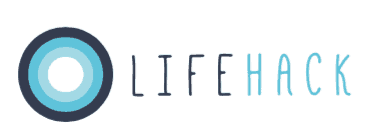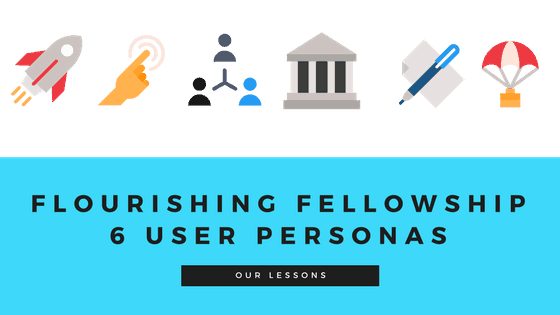How To Use User Personas (And Our Personas From The Fellowship)
User personas are a powerful tool to help clarify who you’re trying to serve and how you can best help them. As a tool from the start-up, marketing and design worlds, we wanted to show you how we’ve used them in our own work, and how you might use them in yours!
But first, what are user personas?
Personas are bundles of roles and situations that have common characteristics. Think of a user persona like a person’s Facebook profile.

Front and center, there’s a photo and name. You can also see some demographic information, like their age, ethnicity, religion and hometown.
Dig a little deeper, you can also see what somebody likes, what drives them and perhaps even what they’re struggling with at that time.
User personas are not sterotypes, because a sterotype contains all sorts of generalisations. User personas contain lots of specific information about an imaginary person you’re trying to reach or serve. And, importantly, they are based on real knowledge about real people.
How to create user personas
Creating user personas is an iterative process that will happen over a few weeks or months. Your end product will be three to six profiles of the sort of people you’re looking to serve.
One of the best ways to create personas is to sit down with a small group around a whiteboard. Getting visual on a whiteboard helps you to see the links and differences.
Basically, you’re trying to create a memorable, identifiable picture of a person you’re trying to serve. Draw a picture, or download an open sourced image off the web, for each persona. Create a name for each one. It can be helpful to use a name that links with their main challenge or need. E.g. Emma is looking for employment. Flossie is having troubles in her flat.
Then, once you’ve got four to six user personas you need to test them out. Don’t worry about being too accurate. Take your first draft and go test the personas on colleagues and collaborators from other organisations. Or, even better, try putting them past the people you’re trying to reach.
Incorporate their feedback, and repeat as long as it feels useful.
If you need more help, check out our post from 2014 about user personas and how you might go about building them. Another favourite template is here on the DIY Toolkit website. It’s more strengths-based than many templates, which focus on “problems” or “pains”.
They sound like hard work. Why bother?
The possibilities with user personas are enormous. That’s why they are one of the few tools that are recommended by marketers, lean start-up folks, designers and IT folks alike.
At a masterclass in her work with Smallfire, Penny had previously shared her thoughts on how you might apply user personas in a health or wellbeing context:
To stay focused on the people
When working with health management teams for example, we might start a workshop with participants reading and introducing personas of people and families/whānau from the community. This helps them work together and remind and ground the team that the focus needs to be people-centred, and decisions grounded in the impact and benefits for people.
To check our understanding of different groups of people with those people
When working with young people we might start by asking them to create an online profile for a simple persona. So converting 5-6 lines of text describing a young person into an image that visualises what would they be saying, hearing, posting, tagging, listening etc. This allows us to check if our understanding and data about those young people is accurate (young people will tell us if the personas don’t ring true).
To make sensitive discussions safe
We’ve used personas in lots of workshops where we want to explore sensitive or private topics. For example young people can tell us about why a persona might act in a certain way – rather than having to disclose specific things about themselves. This is especially useful when talking about sensitive issues such as mental health, sexual health or illegal activities.
To generate people-centred interventions and responses
It’s common for people to have lots of ideas about what should change or the solutions needed. Using personas to test ideas or to generate them, is one way to help ensure that proposed solutions are responding to the needs of real people, and that they account for the reality of
people’s lives.To bring to life the people behind data and statistics
We often use scenarios to give meaning to and communicate quantitative data and statistics – what is actually happening for people on the ground? Scenarios can quickly show this.
To help explore the impacts of systems changes
Scenarios can help stakeholders explore the implications of system and policy level changes on a human level. To help envisage change, cross sector stakeholders can work together to develop a future scenario that shows how people’s’ lives might be different as a result of a change in
policy for example.To facilitate discussion and planning for cross sector systems change
To work out how to achieve a change, cross sector groups might create the ideal scenario, and then work backwards (backcast) to identify the steps we’d need to take to get there.
To co-create interventions
In workshops we’ve asked young people to create their own scenarios, to show how or why someone would or wouldn’t interact with a particular service intervention. Using half finished story boards for example, and asking young people to fill in the gaps that show what would need to be in place for them to want to use or do something (e.g., access a health intervention).
Our Example: User personas for the Flourishing Fellowship
Since 2015, we’ve been continually reflecting on who might be the most important audiences for our programmes. We have captured these reflections in user personas.
For our programmes, it’s often the mix of personas that enables the best results for Fellows and their communities. Below we offer the personas we believe derive the greatest benefits from programmes like the Flourishing Fellowship when brought together to learn from each other.
Those six user personas are:
- Youth Worker
- Community Activator
- Frontline Influencer
- Early Career Government Employee
- Service Planner
- Entrepreneurial Spirit

(The text of this image is pasted into its “Alternative Text” section for people using reading assistance apps.)
How we would use User Personas for future programmes
If we were to run the Fellowship again, we would target our recruitment process to these types of personas. We know this type of programme creates most impact for those who already have the opportunity to apply the learnings, they have the motivation to integrate new ways of working and they have existing capability within the youth wellbeing workforce to influence change.
We would also continue to encourage previous Fellows to nominate their peers and align our messaging to appeal to those personas.
If you’re not yet using User Personas, chat to your team and give them a try!
We hope you’ve found this post useful to explain the purpose of user personas. We encourage you to give them a go if you’re not already using them.
Many people who are initially dubious about user personas end up find them one of the most useful tools for expanding the reach and impact of their mahi.
As for the Flourishing Fellowship, we’ll soon be releasing the 2017 Flourishing Fellowship Impact Report and video. Keep your eyes peeled!


